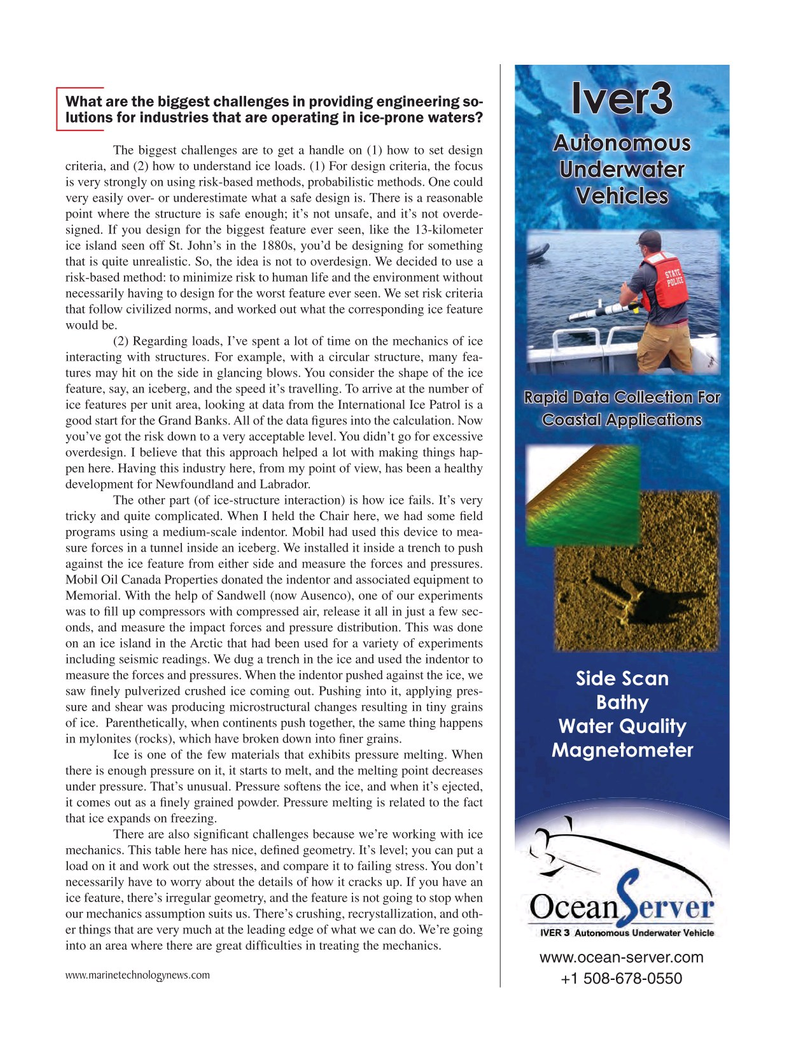
Page 39: of Marine Technology Magazine (October 2016)
AUV Operations
Read this page in Pdf, Flash or Html5 edition of October 2016 Marine Technology Magazine
What are the biggest challenges in providing engineering so-
Iver3 lutions for industries that are operating in ice-prone waters?
Autonomous The biggest challenges are to get a handle on (1) how to set design criteria, and (2) how to understand ice loads. (1) For design criteria, the focus
Underwater is very strongly on using risk-based methods, probabilistic methods. One could very easily over- or underestimate what a safe design is. There is a reasonable
Vehicles point where the structure is safe enough; it’s not unsafe, and it’s not overde- signed. If you design for the biggest feature ever seen, like the 13-kilometer ice island seen off St. John’s in the 1880s, you’d be designing for something that is quite unrealistic. So, the idea is not to overdesign. We decided to use a risk-based method: to minimize risk to human life and the environment without necessarily having to design for the worst feature ever seen. We set risk criteria that follow civilized norms, and worked out what the corresponding ice feature would be. (2) Regarding loads, I’ve spent a lot of time on the mechanics of ice interacting with structures. For example, with a circular structure, many fea- tures may hit on the side in glancing blows. You consider the shape of the ice feature, say, an iceberg, and the speed it’s travelling. To arrive at the number of
Rapid Data Collection For ice features per unit area, looking at data from the International Ice Patrol is a good start for the Grand Banks. All of the data ? gures into the calculation. Now
Coastal Applications you’ve got the risk down to a very acceptable level. You didn’t go for excessive overdesign. I believe that this approach helped a lot with making things hap- pen here. Having this industry here, from my point of view, has been a healthy development for Newfoundland and Labrador. The other part (of ice-structure interaction) is how ice fails. It’s very tricky and quite complicated. When I held the Chair here, we had some ? eld programs using a medium-scale indentor. Mobil had used this device to mea- sure forces in a tunnel inside an iceberg. We installed it inside a trench to push against the ice feature from either side and measure the forces and pressures.
Mobil Oil Canada Properties donated the indentor and associated equipment to
Memorial. With the help of Sandwell (now Ausenco), one of our experiments was to ? ll up compressors with compressed air, release it all in just a few sec- onds, and measure the impact forces and pressure distribution. This was done on an ice island in the Arctic that had been used for a variety of experiments including seismic readings. We dug a trench in the ice and used the indentor to measure the forces and pressures. When the indentor pushed against the ice, we
Side Scan saw ? nely pulverized crushed ice coming out. Pushing into it, applying pres-
Bathy sure and shear was producing microstructural changes resulting in tiny grains of ice. Parenthetically, when continents push together, the same thing happens
Water Quality in mylonites (rocks), which have broken down into ? ner grains.
Magnetometer Ice is one of the few materials that exhibits pressure melting. When there is enough pressure on it, it starts to melt, and the melting point decreases under pressure. That’s unusual. Pressure softens the ice, and when it’s ejected, it comes out as a ? nely grained powder. Pressure melting is related to the fact that ice expands on freezing. There are also signi? cant challenges because we’re working with ice mechanics. This table here has nice, de? ned geometry. It’s level; you can put a load on it and work out the stresses, and compare it to failing stress. You don’t necessarily have to worry about the details of how it cracks up. If you have an ice feature, there’s irregular geometry, and the feature is not going to stop when our mechanics assumption suits us. There’s crushing, recrystallization, and oth- er things that are very much at the leading edge of what we can do. We’re going into an area where there are great dif? culties in treating the mechanics. www.ocean-server.com www.marinetechnologynews.com +1 508-678-0550
MTR #8 (34-49).indd 39 9/28/2016 4:05:29 PM

 38
38

 40
40
